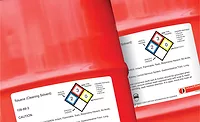How to Sustain Regulatory Compliance for Chemical Labeling
Adhesive and sealant manufacturers’ regulatory departments must be more vigilant than ever in keeping up with evolving standards.

Managing regulatory compliance is a constant challenge for those in the chemical industry. The stakes are even higher today as companies must balance adherence to strict—often exhaustive, always changing—policies and procedures with the desire to embrace digital transformation and accelerate business to keep up with growing global competition. This leaves regulatory affairs, as well as quality and compliance personnel, in the middle, serving as the conduit between standards agencies and senior leadership representing manufacturing, supply chain, and other key operational functions. The back-and-forth can be dizzying as one side expects compliance at all costs and the other desires getting product to customers faster and more efficiently than ever.
Labeling is one such area that crosses departmental boundaries. For manufacturing and supply chain, the barcode label is the passport that enables the fast identification, transport, tracking and delivery of product—from production line to end customer. For the regulatory manager, that same label must conform to myriad regulations and standards, many of which are a moving target due to constant change.
The Globally Harmonized System (GHS) of classifying and labeling chemicals mandates that pictograms with red diamonds, hazard statements, signal words and more appear on applicable finished goods, as well as the variety of drums, cartons, and containers shipped across the supply chain. Country-specific regulations for the import/export of chemicals add even more complexity.
Global Standards,
Emerging Markets
Companies must also pay attention to global standards and regional specific requirements. This gets particularly complicated as companies enter emerging markets where countries like Brazil, China and India, as well as growing economies in Africa, continue to set unique label requirements for their trade partners. As such, regulatory departments must be more vigilant than ever in keeping up with evolving standards.
GS1 is one of the world’s largest organizations that develops and maintains standards to enable trade partners— manufacturers, suppliers, distributors and retailers—to use a common language as products traverse from one party to the next. With more than 1 million members in over 100 countries, GS1 provides numbering and identification systems, as well as barcodes that are captured on labels to help improve visibility and traceability across the international supply chain.
Increasingly, GS1 standards are being recognized and accepted to support regulatory compliance. For example, in the U.S., GS1 standards help support the Food and Drug Administration's (FDA) Food Safety Modernization Act (FSMA) to improved product traceability. As a result, regulatory and compliance departments review GS1 data and barcodes to ensure that their company—and its partners—are properly following standards.
In addition, the management of regulations and standards gets especially tricky as operations expand into other regions of the world. Many countries expect their strict requirements to be met for language, symbologies, transactional data and other criteria. The reasons for these stipulations are valid; they improve the speed and efficiency in how products move through the supply chain. However, they also present their own set of challenges. For instance, in Russia, chemical labels must not only include GHS pictograms, but conform to new standards as defined by that country's technical regulation.
Risks of Non-Compliance
The risks associated with non-compliant labeling vary, but all are damaging, if not potentially crippling. Potential risks include:
• Health and safety issues. Companies never want to put lives in danger due to mislabeling. Unfortunately, there are too many horror stories in recent years in which products were labeled incorrectly, resulting in sickness and even death. Whether it was allergen omissions on food labels, chemicals marked incorrectly or the infiltration of counterfeit drugs with inaccurate labels, the losses are tragic and usually lead to lengthy, costly lawsuits.
• Product recalls. When chemicals are mislabeled, companies typically have to go through an exhaustive recall process, which takes up valuable resources, throws off production schedules and greatly reduces profitability. Most companies have recall procedures in place, but that doesn’t mitigate the significant impact to operations.
• Fines and penalties. Regulatory agencies like the FDA warn violators of fines (upwards of $500,000 or more), seizures, suspension or revocation of licenses and criminal sanctions including imprisonment. While there’s been a bit of a grace period to allow companies to get their processes in place for recent regulations like GHS, agencies will be looking to crack down on violations in the coming months.
• Supply chain disruption. A ripple effect of unforeseen events like product recalls or seizures is an interruption to the flow of goods across your supply chain. What if product is confiscated or even destroyed when crossing international borders? That’s what happens in China if your chemicals are mislabeled. Not only does this impact your bottom line, but it can hurt relationships with customers and trade partners and lead to additional fines.
• Damaged brand/reputation. Beyond health risks and costly fine and delays, non-compliant labels—and the negative publicity they generate—can have a lasting and sometimes irreversible effect on a company’s brand. This situation creates opportunity for competitors and can jeopardize a company’s future.
6 Labeling Best Practices
Although regulatory and compliance teams from different industries have different rules to follow, some common labeling practices can be adopted and applied across all enterprises. Indeed, new advancements in enterprise labeling take these best practices to another level in helping regulatory teams not just sustain compliance, but save time, improve collaboration, and drive overall efficiency across their supply chain.
1. Standardize and centralize labeling.
Standardizing on a single labeling solution certainly isn’t a new concept, but for large organizations dealing with complex regulations, it just doesn’t make sense to rely on disparate, disconnected labeling solutions. When labeling is isolated to the production lines at remote sites, it’s hard to ensure label accuracy and brand consistency across the organization. In addition, the visibility into labeling for key stakeholders at corporate headquarters is limited.
Today’s powerful, enterprise-class labeling solutions make standardization a practical, viable reality. In addition, when control of labeling and secure access to regulatory, quality and other functions within the organization is centralized, the design, review, and printing of labels can be systematically managed. Plus, new cloud-based capabilities make it easy to extend labeling to contract manufacturers, co-packers, suppliers and distributors. In addition, the advent of new multi-site deployment capabilities provides added flexibility by empowering businesses to control label data and make decisions centrally while also allowing remote facilities to operate the labeling function autonomously.
2. Integrate with sources of truth.
Accuracy is paramount in regulatory labeling, but with laws changing and evolving (particularly in global markets), it can be hard to stay current. That’s why it’s critical to integrate labeling directly with your source of compliance data. Continuing to rely on spreadsheets or “file drop” approaches to manage labeling data is asking for trouble. For example, as rules change like in Russia for chemical labeling, you can be confident that, once country-specific product data is captured in your regulatory database, it will be reflected on the label.
When looking to tie your labeling to larger, more complex systems like those from SAP or Oracle, don’t underestimate the value of certified integrations. This provides added peace of mind that your labeling solution has been tested and approved for use in these mission-critical environments.
3. Own your part of the label.
In many organizations, regulatory and compliance teams are often reliant on IT to manage label design and updates. You may ultimately be responsible for what’s on the label, but any significant changes have to go through a cumbersome, time-consuming coding process. Instead, why not simply manage your part of the label? New layering capabilities let different groups own and control their portion of the label. As part of the regulatory team, you can add requisite pictograms, symbols, safety information, etc., and apply it to the appropriate labels. This not only streamlines approvals, but supports mass updates to appropriate labels to ensure accuracy and consistency.
Make sure labeling tools are intuitive and easy to use. Look for a WYSIWYG interface that lets you view labels with real data and see what it looks like before going to print. In addition, drag-and drop rules creation lets regulatory departments configure the logic that pertains to their specific labels—including what templates receive a certain warning hazard or language change.
4. Create a “closed loop” workflow and approval process.
With so many people involved with labeling, it’s critical to have a systematic workflow process to make sure no one is left out—especially regulatory personnel. The manual or disconnected approaches of the past create too many cycles and increase the risk of errors and mislabeling. Fortunately, today’s enterprise labeling solutions can automate workflow to streamline the review and approval of labels, content and artwork, helping to ensure that the right people are included. Look for solutions where workflows are easily configurable to match your way of doing business.
5. Gain critical insight for auditing and reporting.
With labeling regulations continuing to increase and evolve, it’s important that companies are able to quickly monitor, track, and capture labeling activity—down to the label, printer, and users. Who knows when governing bodies like the OSHA will audit your operation? Now you can leverage built-in business intelligence to pull data and create customized reports that address a wide range of regulatory requirements in a validated environment.
Interactive dashboards are available that go beyond simply reporting and provide real-time status of labels, workflows, print requests, configurations and user actions—from creation and approval to publication and print. This allows both labeling professionals and auditors to know that processes are operating in accordance with key performance indicators, as well as strict regulatory guidelines. Real-time insight also helps organizations make faster, more informed decisions to improve labeling.
6. Scale easily to enter—and comply with—new markets.
As companies look to enter new and emerging markets, they must contend with unique and country-specific regulatory requirements. A centralized approach to labeling helps organizations be more proactive in designating resources and aligning with new requirements, such as localized languages that must go on the label. Today’s most advanced enterprise labeling solutions can support more than 10 languages out of the box, with the tools to add and modify languages as needed.
When you leverage built-in business logic found in enterprise-class labeling solutions, you have limitless flexibility to support a wide range of label variability including regional languages, symbols, and customer-specific requirements. Again, this logic can be applied without complicated coding and IT involvement. ASI
For more information, visit www.loftware.com.
Looking for a reprint of this article?
From high-res PDFs to custom plaques, order your copy today!



